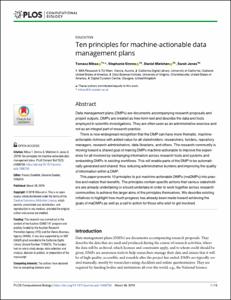| dc.contributor.author | Miksa, T. | |
| dc.contributor.author | Simms, S. | |
| dc.contributor.author | Mietchen, D. | |
| dc.contributor.author | Jones, Sarah | |
| dc.date.accessioned | 2021-07-27T21:07:43Z | |
| dc.date.available | 2021-07-27T21:07:43Z | |
| dc.date.issued | 2019 | |
| dc.identifier.citation | Miksa, T., Simms, S., Mietchen, D. and Jones, S.
(2019) Ten principles for machine-actionable data
management plans. PLoS Computational Biology, 5(3):
e1006750, 15pp. DOI: https://doi.org/10.1371/journal.
pcbi.1006750 | en_US |
| dc.identifier.uri | https://repository.oceanbestpractices.org/handle/11329/1630 | |
| dc.identifier.uri | http://dx.doi.org/10.25607/OBP-1562 | |
| dc.description.abstract | Data management plans (DMPs) are documents accompanying research proposals and
project outputs. DMPs are created as free-form text and describe the data and tools
employed in scientific investigations. They are often seen as an administrative exercise and
not as an integral part of research practice.
There is now widespread recognition that the DMP can have more thematic, machineactionable
richness with added value for all stakeholders: researchers, funders, repository
managers, research administrators, data librarians, and others. The research community is
moving toward a shared goal of making DMPs machine-actionable to improve the experience
for all involved by exchanging information across research tools and systems and
embedding DMPs in existing workflows. This will enable parts of the DMP to be automatically
generated and shared, thus reducing administrative burdens and improving the quality
of information within a DMP.
This paper presents 10 principles to put machine-actionable DMPs (maDMPs) into practice
and realize their benefits. The principles contain specific actions that various stakeholders
are already undertaking or should undertake in order to work together across research
communities to achieve the larger aims of the principles themselves. We describe existing
initiatives to highlight how much progress has already been made toward achieving the
goals of maDMPs as well as a call to action for those who wish to get involved. | en_US |
| dc.language.iso | en | en_US |
| dc.rights | Attribution 3.0 United States | * |
| dc.rights.uri | http://creativecommons.org/licenses/by/3.0/us/ | * |
| dc.subject.other | Data management plans | en_US |
| dc.subject.other | Machine readable forms | en_US |
| dc.title | Ten principles for machine-actionable data management plans. | en_US |
| dc.type | Journal Contribution | en_US |
| dc.description.refereed | Refereed | en_US |
| dc.format.pagerange | 15pp. | en_US |
| dc.identifier.doi | https://doi.org/10.1371/journal. pcbi.1006750 | |
| dc.subject.parameterDiscipline | Cross-discipline | en_US |
| dc.subject.dmProcesses | Data management planning and strategy development | en_US |
| dc.bibliographicCitation.title | PLOS Computational Biology | en_US |
| dc.bibliographicCitation.volume | 15 | en_US |
| dc.bibliographicCitation.issue | 3, Article e1006750 | en_US |
| dc.description.sdg | 14.a | en_US |
| dc.description.eov | N/A | en_US |
| dc.description.methodologyType | Method | en_US |
| dc.description.methodologyType | Specification of criteria | en_US |
| obps.contact.contactname | T. Miksa | |
| obps.contact.contactemail | miksa@ifs.tuwien.ac.at | |
| obps.resourceurl.publisher | https://journals.plos.org/ploscompbiol/article?id=10.1371/journal.pcbi.1006750 | |
 Repository of community practices in Ocean Research, Applications and Data/Information Management
Repository of community practices in Ocean Research, Applications and Data/Information Management

